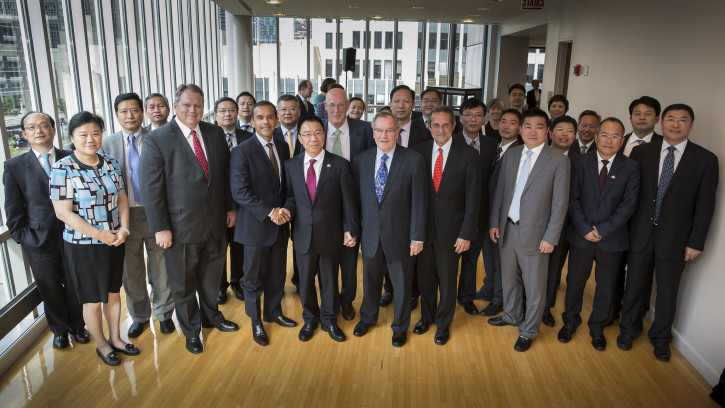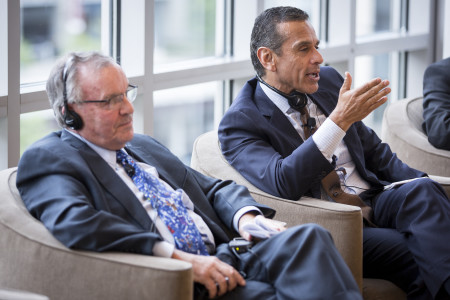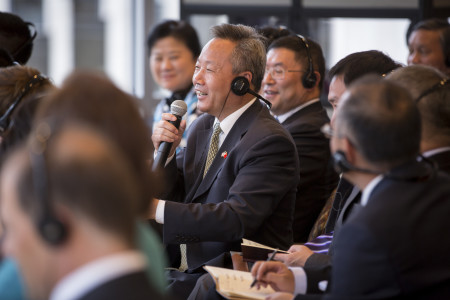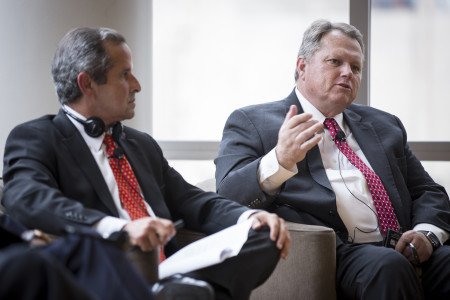
Mayors, in practice, are problem solvers. And so when Antonio Villaraigosa of Los Angeles, Manny Diaz of Miami, Richard Daley of Chicago, and Scott Smith of Mesa, ex-mayors of some of America’s largest and most dynamic cities, sat down at the University of Chicago’s Gleacher Center with 22 Chinese mayors and urban officials from Zhejiang province, there was plenty of common language. From nitty gritty transportation and traffic management to the broader challenges of building a green city and sustainable economic transformation—these were all themes that both the American and Chinese mayors had grappled with.
China’s mayors these days have a truly historic responsibility: With 100 million people expected to move to cities over the next decade, China’s metropolises are experiencing rapid growth and evolution. That raises the stakes for urban planners to implement effective policy and design. “What makes China go is the mayors,” said Paulson Institute Chairman Hank Paulson. The mayors, he added, “have to figure out how to have environmentally sustainable policies, and also how to grow the economy at an acceptable level.” The Paulson Institute’s Mayors Training Program, which organized the mayors’ event, brought the group of Zhejiang mayors to the United States for three weeks of intensive training in sustainability practices. The annual program, which is supported by the Hyatt Hotels Corporation, aims to help China’s mayors find the best tools for the job.

Successful urbanization, Paulson added, will require effective leadership, especially at the local level. Paulson asked each of the U.S. mayors to share one piece of advice on leadership. “Strong leaders must have a vision for the future, and the ability to carry out that vision,” posited former Chicago Mayor Daley. To Mayor Villaraigosa, great leadership means “being willing to fail.” He said his proudest moment, as a Latino mayor, was proving that he “could be everyone’s mayor. We were uniters.”
Just a few years ago, a conversation with Chinese mayors about sustainability would have largely focused on economic costs associated with greening and how to balance the budget. But the Chinese visitors instead wanted to talk about the “softer” issues—like personal life and how to be a good leader. Their questions reflected how much their jobs have broadened beyond a singular focus on economic development to the bigger challenge of creating cities that really offer a good life for their residents.

How did you get people to buy into your big goals, one mayor asked? Mayor Diaz’s reply: he got the garbage collector to believe in his contribution to Forbes citing Miami as the cleanest city in the US in 2008. Mayor Smith talked about celebrating milestones and making accomplishments visible. (His city architects wanted to hide solar panels, but he put them on the rooftops so all could see.) Mayor Daley talked about government leading by example (he made all the government buildings meet green, energy efficiency standards).
How do you balance work with personal life, another mayor asked. Have a great spouse, Mayor Daley said. Mayor Smith talked about including family in public events: his grand daughter sat onstage with him for a big announcement.

The Chinese audience pressed on, asking how the American mayors built consensus—and how they each compromised to win support. “Most people you meet with won’t have the same vision you have,” answered Mayor Smith. “You can compromise on things along your route, as long as you are fixed on reaching your destination.”
As the Chinese mayors gear up to steer their cities through the next phase of urbanization, they will be able to draw lessons from fellow mayors in America who know a thing or two about how to connect with the common man. For Los Angeles’ Villaraigosa, that included taking then Vice President Xi Jinping to a Los Angeles Lakers game in 2012—and somehow convincing Xi to ditch his tie.


